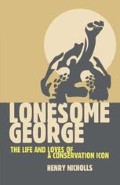Abstract
Until the 1990s, Lonesome George spent most of his captive life isolated from all other tortoises at the Charles Darwin Research Station (CDRS), alone in his spacious pen on the coast. As the Galápagos tourist industry and George’s popularity grew, he needed a more prominent compound. In 1988, Linda Cayot, head of reptiles at the CDRS, floated designs for a new enclosure at the end of the tourist trail through the research station. Work was completed in early 1992 and George took up residency. At the same time, Cayot took a big step. She put two females into George’s new pen — females from the northernmost volcano on Isabela Island.
Preview
Unable to display preview. Download preview PDF.
Notes and sources
Overview of George’s life at the CDRS: Linda Cayot and Roslyn Cameron, personal communication
Outbreeding depression in ibex: cited in Frankham et al. (2002); van Wieren et al. (2005)
Hybridization of red wolves with coyotes: see Frankham et al. (2002); Wayne (1996); Wilson et al. (2000)
Inbreeding depression in the Florida panther: see Culver et al. (2000)
Townsend visit to collect the last remaining Galápagos tortoises: Townsend (1928)
Efforts to breed tortoises at the CDRS: Corley Smith (1976)
‘Visit Lonesome George, the world’s oldest living gay turtle’: www.flamingo-travel.com
Ubiquity of homosexuality in the animal kingdom: Bagemihl (2000)
Early learning influences adult behaviour: see Freeberg (2000)
Japanese quails watching TV: Ophir and Galef (2003)
’some animal species show increased interest …’: Fritts (2002)
‘Potentially the visual, olfactory, and even auditory stimuli …’: Fritts (2002)
Captive breeding of Seychelles and Arnold’s tortoises: Justin Gerlach, personal communication
von Hegel’s technique: Gisela von Hegel, personal communication
’she could do this in just a few minutes’: Cayot, personal communication
Semen collection and artificial insemination in elephants: Thomas Hildebrandt, personal communication ‘looks like the greatest Swiss cheese’: Hildebrandt, personal communication
‘the penis is actually a structure that you never should touch’: Hildebrandt, personal communication
Details of Sveva Grigioni’s work with George: Grigioni (1993); Grigioni and Cayot, personal communication
’sveva could get the other male tortoises …’: Cayot, personal communication
‘He was very shy at the beginning’: Grigioni, personal communication
‘if a single female moth were to release all the bombykol …’: Lewis (1995)
Wedekind’s T-shirt experiment: Wedekind et al. (1995)
Mexican rams: Lezama et al. (2001)
‘Day by day, he started to be more interested in the females …’: Grigioni, personal communication
‘If I had had more time …’: Grigioni, personal communication
Copyright information
© 2010 Henry Nicholls
About this chapter
Cite this chapter
Nicholls, H. (2010). Lonesome George’s Girlfriend. In: Lonesome George. Macmillan Science. Palgrave Macmillan, New York. https://doi.org/10.1007/978-1-137-09745-3_2
Download citation
DOI: https://doi.org/10.1007/978-1-137-09745-3_2
Publisher Name: Palgrave Macmillan, New York
Print ISBN: 978-0-330-45011-9
Online ISBN: 978-1-137-09745-3
eBook Packages: Palgrave History CollectionHistory (R0)

